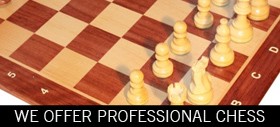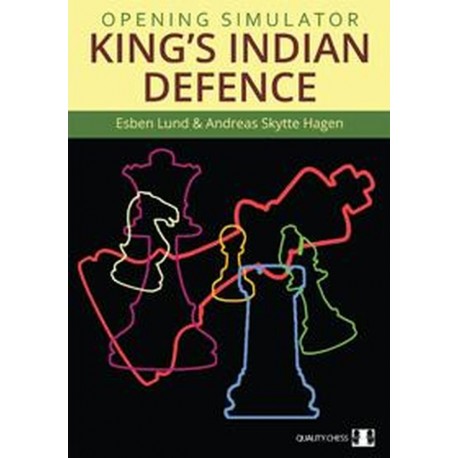No products
Opening Simulator - King's Indian Defence - Andreas Skytte Hagen, Esben Lund (K-5678)
K-5678
New product
The King’s Indian Defence is a popular opening at all levels. Fischer, Kasparov, Bronstein, Nunn, Radjabov and Nakamura are just a few of the many leading GMs who have played it successfully.
- Write a review
Data sheet
| Language versions | English |
| Author / Authors | Andreas Hagen, Esben Lund |
| Publisher | Quality Chess |
| Year of Publication | 1st edition 2019 |
| Pages | 272 |
| ISBN | 9781784830816 |
| Hardcover | No |
| Paperback | Yes |
| Downloadable | No |
| Width | 17 cm / 6.69 inch |
| Height | 24 cm / 9.45 inch |
More info
Opening Simulator is a new and innovative approach to studying the opening, based on the Deliberate Practice concept. Rather than presenting moves and variations, the authors offer a 'read, solve and play' approach which is designed to replicate a real game more closely than other opening books. First, a thorough Introduction discusses the main variations, pawn structures and themes. Then, after working through the 400 carefully chosen exercises, the reader will benefit from enhanced tactical and problem-solving ability.
Unlike a normal puzzle book, the exercises all stem from the King’s Indian, making this book the ideal resource for King’s Indian players of all abilities to hone their skills.
Andreas Skytte Hagen is a Danish IM with one GM norm, and an experienced King’s Indian player who came up with the Opening Simulator concept.
Esben Lund is a Danish IM and a respected author and trainer. He is a 1.d4 player with extensive experience playing against the King’s Indian, thus both sides are represented in this book.
Reviews

Content
005 Key to symbols used
005 Bibliography
007 Preface
009 1. Introduction to the book
011 2. Introduction to the King’s Indian Defence
011 2.1 The ECO classification system
012 2.2 What is the King’s Indian?
013 2.3 King’s Indian Variations
014 2.3.1 The Classical Variation
014 2.3.1.1 Classical with ...e5
017 2.3.1.1.1 The Immediate Release of the Central Tension
017 2.3.1.1.1.1 Black Releases the Tension
018 2.3.1.1.1.2 The Exchange Variation
019 2.3.1.1.1.3 The Petrosian Variation
021 2.3.1.1.2 Mar del Plata Variation
022 2.3.1.1.2.1 The Aronin-Taimanov Variation
028 2.3.1.1.2.2 The Bayonet Attack
030 2.3.1.2 Classical King’s Indian with 6...c5
031 2.3.1.2.1 The Benoni Centre
031 2.3.1.2.2 The Maroczy Centre
035 2.3.2 The Averbakh Variation
039 2.3.3 The Four Pawns Attack
042 2.3.4 Lines with h2-h3
042 2.3.4.1 Black plays ...c5 against h2-h3 lines
045 2.3.4.2 Black plays ...e5 against h2-h3 lines
045 2.3.4.2.1 The Makogonov Variation
047 2.3.4.2.2 The Karpov Variation
049 2.3.5 The Sämisch Variation
049 2.3.5.1 White keeps the central tension after ...c5
050 2.3.5.2 Black plays ...e5 against the Sämisch
052 2.3.5.3 Move-order considerations in the Sämisch
054 2.3.5.4 Bronstein’s queen sacrifice
054 2.3.5.5 Main Line with 6.Be3 e5
056 2.3.5.6 Universal set-up with ...Nc6, ...a6 & ...Rb8 (Panno Variation)
059 2.3.5.7 Sämisch Benoni
061 2.3.6. The Fianchetto Variation
062 2.3.6.1 Black plays ...Nc6 against the Fianchetto
062 2.3.6.1.1 The Panno Variation
065 2.3.6.1.2 The Uhlmann Variation
068 2.3.6.2 Black plays ...Nbd7 against the Fianchetto
068 2.3.6.2.1 The Gallagher Variation
071 2.3.6.2.2 Classical Variation with 8...c6 against the Fianchetto
073 2.3.7 Other lines
073 2.3.7.1 Black plays on the queenside with ...a6, ...c6 and ...b5
074 2.3.7.2 The Smyslov System with Bg5 and e2-e3
076 2.3.7.3 The Czech Benoni
077 2.4. Other King’s Indian considerations
077 2.4.1 The King’s Indian set-up with ...e5 and ...c5
084 2.4.2 The c5-d6-e5 structure with the knight on d7 (Kozul’s pet line)
087 2.4.3 The impact of space in the King’s Indian
088 2.4.4 Is the King’s Indian a strategically suspect opening?
089 2.5 Move orders: 4...d6 or 4...0– 0
090 2.5.1 The Classical Variation (it usually doesn’t work!)
091 2.5.2 Other lines (move-order tricks can pay off!)
094 3. Exercises
098 3.1 Level 1 exercises
108 3.2 Level 2 exercises
123 3.3 Level 3 exercises
140 3.4 Level 4 exercises
155 3.5 Level 5 exercises
4. Solutions to Exercises
165 4.1 Solutions to Level 1
171 4.2 Solutions to Level 2
184 4.3 Solutions to Level 3
204 4.4 Solutions to Level 4
234 4.5 Solutions to Level 5
263 5. Name Index











